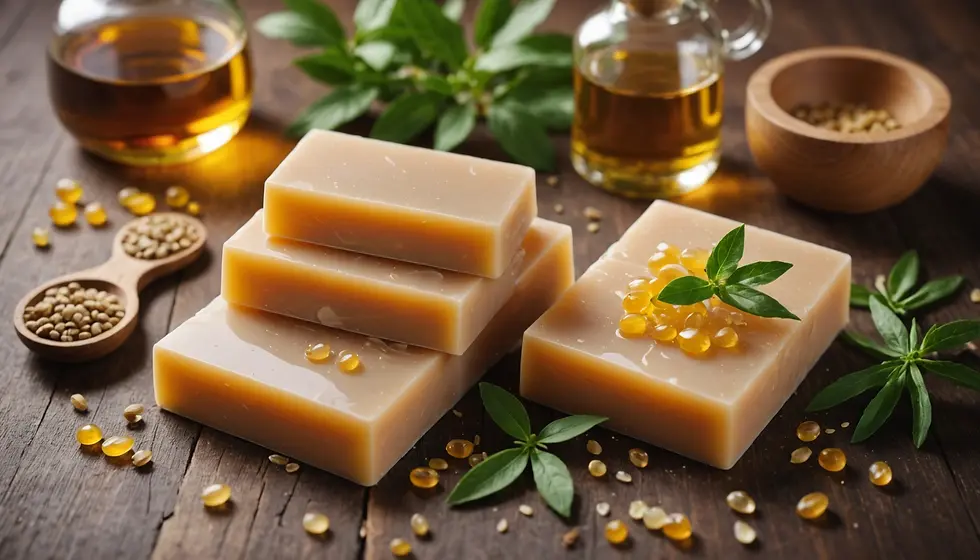Why Cold Process Soaps Reign Supreme Over Melt & Pour Soaps: An Editorial Analysis for Natural Skincare Enthusiasts and Professionals
- Naren MG
- Dec 16, 2024
- 4 min read
Updated: Dec 29, 2024
The soap-making world is vast and vibrant, filled with creativity and choices. Among the most discussed techniques are cold process and melt-and-pour soaps, each attracting attention from both artisans and skincare enthusiasts. However, if you're aiming for a truly enriching, chemical-free product that nurtures healthy skin, cold process soaps have a distinct edge. This method not only fulfills the desires of natural product lovers but also resonates deeply with skincare professionals.
Understanding the differences between these two techniques and their benefits will empower you to make better choices for your skincare routine.
The Essence of Cold Process Soaps
Cold process soap making stands out due to a fundamental chemical process called saponification. Here, oils transform into soap through a reaction with an alkali, such as lye. This method offers complete control over the ingredients, allowing artisans to choose natural oils, essential oils, and botanicals that cater specifically to various skin needs.
For instance, using coconut oil can enhance lather, while almond oil provides soothing properties. A blend containing essential oils like lavender or tea tree can add calming or antibacterial benefits. Cold process soaps retain natural glycerin, a powerful moisturizer. Studies show that glycerin can increase skin hydration by up to 30%, giving these soaps a luxuriously soft feel, which many people seek for a radiant complexion.

Exploring the Melt & Pour Method
Melt-and-pour soap is often recommended for beginners who want to explore soap crafting with ease. This method typically involves melting down a pre-made soap base, usually made from glycerin, and customizing it with colors, fragrances, and essential oils. While it provides convenience, melt-and-pour soaps often fail to deliver the rich, luxurious experience associated with cold process soaps.
One major drawback is that pre-made bases can include synthetic ingredients or chemical additives. For example, many melt-and-pour bases contain sodium lauryl sulfate, which can irritate sensitive skin. While this method may offer a quick and fun avenue for creativity, it often lacks the deep nourishing properties found in thoughtfully crafted cold process soaps.

Ingredient Control
A significant advantage of cold process soap is the freedom to choose every ingredient. This control enables the soap maker to use only the finest skincare components. For instance, you can include jojoba oil for its skin-conditioning properties or shea butter for deeply nourishing effects.
Crafting your soap means you can cater to your specific skin sensitivities and concerns. If someone struggles with eczema, for example, they can incorporate soothing ingredients like oat oil or calendula extract. In contrast, melt-and-pour methods strictly limit customization to the ingredients in the pre-made bases, leading to less personalized skincare solutions.
Saponification and Glycerin Retention
Saponification is integral to the cold process, creating glycerin, a natural humectant that draws moisture from the environment. Research has shown that soaps retaining high glycerin levels can increase skin hydration significantly, aiding in skin health.
In contrast, melt-and-pour soaps see much of their glycerin filtered out, which can lead to dryness and irritation. Interestingly, some users may experience skin issues due to the higher concentrations of synthetic additives, leaving them wanting for the nurturing qualities natural cold process soaps provide.
Customization and Personalization
Cold process soaps offer endless possibilities for customization. Want a bar for sensitive skin? Infuse it with chamomile. Looking for a refreshing touch? Add citrus essential oils and exfoliating coffee grounds. This level of personalization is cherished by natural skincare enthusiasts, allowing them to create unique solutions tailored to their individual needs.
While melt-and-pour methods allow for adding colors or scents, the foundations remain limited. Pre-made bases restrict the depth of personalization, often resulting in a less tailored approach to skincare. This lack of customization may create missed opportunities for users seeking specific benefits from their skincare routine, especially when considering the benefits of coconut oil, castor oil, sunflower oil, and rice bran oil.
SEO Keywords
coconut oil skincare benefits
castor oil for skin health
sunflower oil moisturizing properties
rice bran oil skin conditioning advantages
Environmental Impact
Today’s environmentally conscious consumers need to consider the environmental impact of their beauty products. Cold process soaps generate minimal waste and can be crafted using sustainable, organic ingredients sourced ethically. According to a 2020 report, sustainable personal care products are valued at over $13 billion, highlighting consumer preference for eco-friendly options.
In contrast, melt-and-pour soaps usually come packaged in plastic, potentially ending up in landfills. For those who prioritize sustainability, adopting practices that reduce waste and promote environmental responsibility is crucial.
Elevating Your Soap-Making Experience
Choosing between soap-making methods ultimately comes down to personal values and skincare goals. For natural product lovers and skincare professionals, cold process soaps prevail as the ideal choice. With unparalleled ingredient control, superior moisturizing properties, limitless customization options, and a commitment to sustainable practices, cold process soaps not only promote healthy skin but also enhance the soap-making experience.
Investing time in creating cold process soaps fosters a deeper connection with your products. This hands-on approach encourages mindfulness about the ingredients you use and how they affect your skin. It’s a rewarding journey that leads to not just glowing skin but also a sense of fulfillment in nurturing your body with carefully crafted, natural products.





Comments